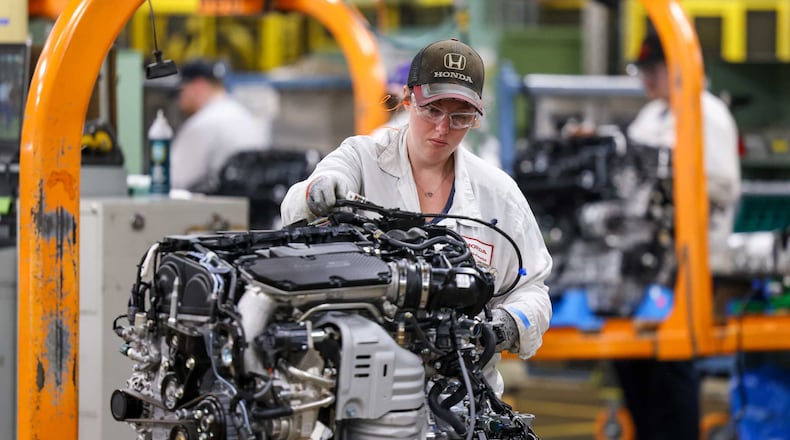With Honda investing $700 million into the Anna engine plant as part of the company’s electric vehicle (EV) plans in Ohio, sometimes employees have questions about their place with the company, said Tinch, who leads the plant located about an hour north of Dayton.
He has reassuring words for them.
“We call it ‘the engine plant,’ but we’ve made all kinds of parts here,” Tinch said.
“This is another evolution of this plant. This plant has been able to adapt,” said Van Gundy, who has worked at the plant since five months after it opened.
Van Gundy said “continuous change” is the norm at Anna. He is confident the plant will remain a vital part of Honda in North America.
“If you haven’t been here in a year, it’s going to be different than it was a year ago,” he said.
EV plans on track in Ohio
The interviews with Tinch and Van Gundy came after Honda leaders in Japan in May indicated a scaling back of EV plans to focus on hybrids. The automaker said it was setting aside a goal of having 30% of its vehicles electric by 2030.
“The change has no direct effect on Ohio due to our flexible manufacturing approach,” Honda spokesman Eric Mauk said more recently.
Honda’s approach to EVs is to plan its manufacturing based on customer demand, he said.
“All of the plants in the U.S. have the ability to adjust their ICE (internal combustion engine) and hybrid vehicle production to meet demand as we initiate full EV production capabilities, and that is what we are seeing in Ohio at the moment,” Mauk said.
Workers at the company’s Anna plant have long demonstrated their adaptability. In the past, they have produced dry shafts, suspension parts, disc brakes, wheels, transmissions and more.
Now, the plant is being readied to make the cases for the Intelligent Power Unit (IPU) that houses the EV battery module and hardware. Battery case production, for EVs made in Marysville and East Liberty, may begin early in 2026.
But the Anna plant will continue to make ICE engines as long as customers want them, Tinch told the Dayton Daily News.
“We’ve already demonstrated that we have the ability to be flexible,” he said. “We’ve demonstrated that we can change our production plans and our specs very quickly with whatever the customers need.”
Preparing to make EV battery cases is “not really that different from what the Anna engine plant has done for the last 30 years, 40 years,” he added.
Anna is Honda’s largest engine plant in the world. Some 2,900 employees at the 2.8-million-square-foot plant make engines for Honda vehicles made in Ohio, Canada, Mexico and even some made in Japan.
Gold Wing motorcycle engines were Anna’s first products. Production of Civic engines started a year or two later.
The plant is unmistakably in a rural area, but Tinch said Honda never had had issues finding good employees.
“This was one of the first bigger plants in the area,” he said. “It’s kind of simple, but you have a lot of farmland around here, a lot of farmers. And their work ethic and their integrity, and their ability to learn and build and construct things, has been pretty impressive over the years.
“We continue to pull a lot of people from this area,” he added.
A longtime production worker, Van Gundy, 65, started with Honda in August 1982, working at the Marysville motorcycle plant before moving to the Marysville auto plant stamping department in 1983.
When Honda announced that the Anna plant would be built, he started the transfer process, joining the plant’s engine test-firing area in January 1986.
The Lima-area resident works for the plant’s accounting staff today. He is a veteran for production and plant planning and helping with design of new models.
Van Gundy likens the plant to a human. When the plant started in 1985, it was a “child.”
“As the years have gone by, we’ve gone from the learning stage, which we’re never going to stop doing here, to the teaching stage,” he said. Workers from Anna routinely help other engine plants in North America, in Mexico, Canada and Alabama.
Van Gundy wasn’t surprised Anna was chosen for a role in Honda’s Ohio EV Hub.
“It wasn’t surprising that they made that announcement because of Anna’s history,” he said.
Millions of engines
Today, they plant produces about 1.1 million engines a year, and it has made more than 32 million engines total. Engine assembly takes place over two shifts, but production of other parts — cam shafts, cylinder sleeves, blocks, heads, pulleys and more — requires three shifts.
“It’s hard to even get your arms around that, how many engines that is,” Tinch said.
Anna-produced engines are found today in CRVs, Civics, Accords and more, nearly every Honda vehicle, except the Passport, Pilot, Odyssey and Ridgeline.
Even as EV preparation continues, Anna still makes about 4,800 ICE engines each day.
“I think we’re going to have (internal combustion) engine production for quite some time,” Tinch said.
Honda keeps its thumb on the pulse of customer desires, he and others say.
“We are still going very much ahead with internal combustion and hybrid electric engines,” he said. “That will continue.”
About the Author



